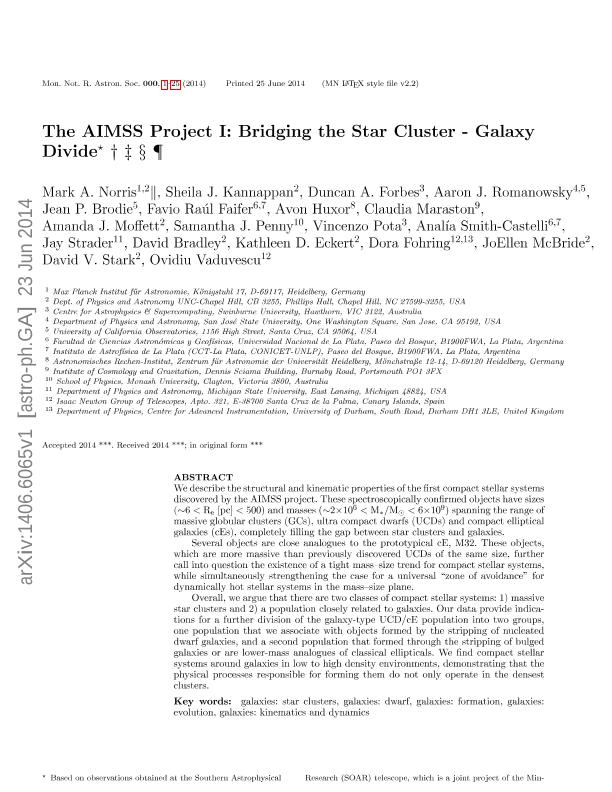Mostrar el registro sencillo del ítem
dc.contributor.author
Norris, Mark A.
dc.contributor.author
Kannappan, Sheila J.
dc.contributor.author
Forbes, Duncan A.
dc.contributor.author
Romanowsky, Aaron J.
dc.contributor.author
Brodie, Jean P.
dc.contributor.author
Faifer, Favio Raúl
dc.contributor.author
Huxor, Avon
dc.contributor.author
Maraston, Claudia
dc.contributor.author
Moffett, Amanda J.
dc.contributor.author
Penny, Samantha J.
dc.contributor.author
Pota, Vincenzo
dc.contributor.author
Smith Castelli, Analia Viviana

dc.contributor.author
Strader, Jay
dc.contributor.author
Bradley, David
dc.contributor.author
Eckert, Kathleen D.
dc.contributor.author
Fohring, Dora
dc.contributor.author
McBride, JoEllen
dc.contributor.author
David V. Stark
dc.contributor.author
Vaduvescu, Ovidiu
dc.date.available
2017-01-06T17:15:02Z
dc.date.issued
2014-09
dc.identifier.citation
Norris, Mark A. ; Kannappan, Sheila J. ; Forbes, Duncan A. ; Romanowsky, Aaron J. ; Brodie, Jean P.; et al.; The AIMSS Project I: bridging the star cluster, galaxy divide; Wiley; Monthly Notices Of The Royal Astronomical Society; 443; 1151; 9-2014; 1151-1172
dc.identifier.issn
0035-8711
dc.identifier.uri
http://hdl.handle.net/11336/10917
dc.description.abstract
We describe the structural and kinematic properties of the first compact stellar systems discovered by the AIMSS project. These spectroscopically confirmed objects have sizes (∼6 < Re [pc] < 500) and masses (∼2×106 < M∗/M < 6×109
) spanning the range of massive globular clusters (GCs), ultra compact dwarfs (UCDs) and compact elliptical galaxies (cEs), completely filling the gap between star clusters and galaxies.
Several objects are close analogues to the prototypical cE, M32. These objects,
which are more massive than previously discovered UCDs of the same size, further
call into question the existence of a tight mass–size trend for compact stellar systems, while simultaneously strengthening the case for a universal “zone of avoidance” for dynamically hot stellar systems in the mass–size plane.
Overall, we argue that there are two classes of compact stellar systems: 1) massive
star clusters and 2) a population closely related to galaxies. Our data provide indications for a further division of the galaxy-type UCD/cE population into two groups, one population that we associate with objects formed by the stripping of nucleated dwarf galaxies, and a second population that formed through the stripping of bulged galaxies or are lower-mass analogues of classical ellipticals. We find compact stellar systems around galaxies in low to high density environments, demonstrating that the physical processes responsible for forming them do not only operate in the densest clusters.
dc.format
application/pdf
dc.language.iso
eng
dc.publisher
Wiley

dc.rights
info:eu-repo/semantics/openAccess
dc.rights.uri
https://creativecommons.org/licenses/by-nc-sa/2.5/ar/
dc.subject
Galaxies
dc.subject
Stars
dc.subject
Globular Clusters
dc.subject
Formation of Galaxies
dc.subject
Evolution of Galaxies
dc.subject
Massive Stars
dc.subject.classification
Otras Ciencias Naturales y Exactas

dc.subject.classification
Otras Ciencias Naturales y Exactas

dc.subject.classification
CIENCIAS NATURALES Y EXACTAS

dc.subject.classification
Otras Ciencias Naturales y Exactas

dc.subject.classification
Otras Ciencias Naturales y Exactas

dc.subject.classification
CIENCIAS NATURALES Y EXACTAS

dc.title
The AIMSS Project I: bridging the star cluster, galaxy divide
dc.type
info:eu-repo/semantics/article
dc.type
info:ar-repo/semantics/artículo
dc.type
info:eu-repo/semantics/publishedVersion
dc.date.updated
2017-01-02T18:36:52Z
dc.journal.volume
443
dc.journal.number
1151
dc.journal.pagination
1151-1172
dc.journal.pais
Reino Unido

dc.journal.ciudad
Londres
dc.description.fil
Fil: Norris, Mark A. . Max Planck Institut für Astronomie; Alemania
dc.description.fil
Fil: Kannappan, Sheila J. . University Of North Carolina; Estados Unidos
dc.description.fil
Fil: Forbes, Duncan A. . Swinburne University. Centre for Astrophysics & Supercomputing; Australia
dc.description.fil
Fil: Romanowsky, Aaron J. . University of California; Estados Unidos
dc.description.fil
Fil: Brodie, Jean P.. University of California; Estados Unidos
dc.description.fil
Fil: Faifer, Favio Raúl . Consejo Nacional de Investigaciones Científicas y Técnicas. Centro Científico Tecnológico La Plata. Instituto de Astrofísica de La Plata; Argentina
dc.description.fil
Fil: Huxor, Avon . Universit¨at Heidelberg. Zentrum f¨ur Astronomie. Astronomisches Rechen-Institut; Alemania
dc.description.fil
Fil: Maraston, Claudia . Institute of Cosmology and Gravitation. Dennis Sciama Building; Estados Unidos
dc.description.fil
Fil: Moffett, Amanda J. . University Of North Carolina; Estados Unidos
dc.description.fil
Fil: Penny, Samantha J. . Monash University. School of Physics; Australia
dc.description.fil
Fil: Pota, Vincenzo . Swinburne University. Centre for Astrophysics & Supercomputing; Australia
dc.description.fil
Fil: Smith Castelli, Analia Viviana. Consejo Nacional de Investigaciones Científicas y Técnicas. Centro Científico Tecnológico La Plata. Instituto de Astrofísica de La Plata; Argentina. Universidad Nacional de la Plata. Facultad de Ciencias Astronómicas y Geofísicas; Argentina
dc.description.fil
Fil: Strader, Jay . Michigan State University; Estados Unidos
dc.description.fil
Fil: Bradley, David . University Of North Carolina; Estados Unidos
dc.description.fil
Fil: Eckert, Kathleen D. . University Of North Carolina; Estados Unidos
dc.description.fil
Fil: Fohring, Dora . Isaac Newton Group of Telescopes; España
dc.description.fil
Fil: McBride, JoEllen . University Of North Carolina; Estados Unidos
dc.description.fil
Fil: David V. Stark. University Of North Carolina; Estados Unidos
dc.description.fil
Fil: Vaduvescu, Ovidiu . Isaac Newton Group of Telescopes; España
dc.journal.title
Monthly Notices Of The Royal Astronomical Society

dc.relation.alternativeid
info:eu-repo/semantics/altIdentifier/url/http://mnras.oxfordjournals.org/content/443/2/1151
dc.relation.alternativeid
info:eu-repo/semantics/altIdentifier/doi/http://dx.doi.org/10.1093/mnras/stu1186
Archivos asociados
